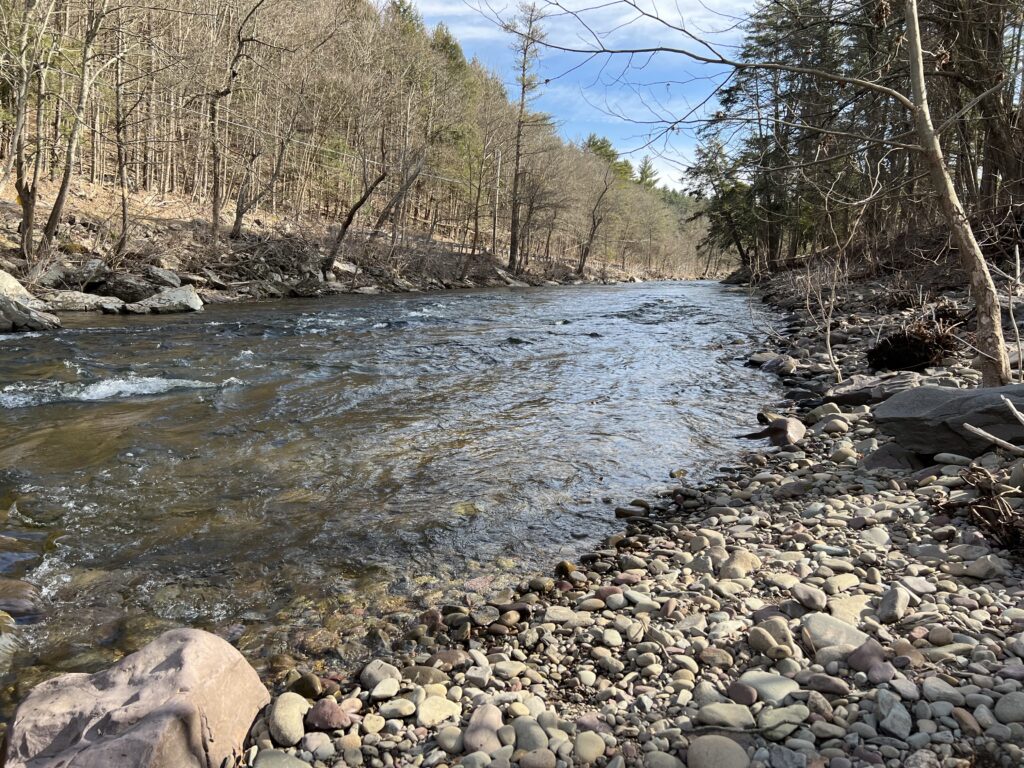
Streams in the Delaware River watershed face a variety of threats
Pa. water quality report should be a ‘call to arms,’ expert says
| April 20, 2022
Editor’s note:
For Earth Day, Delaware Currents launches another one of its ambitious projects.
This story kicks off a 10-part series to help you understand the health of the nine basins in Pennsylvania that are part of the Delaware River’s watershed. The findings are drawn from the Pennsylvania Department of Environmental Protection’s 2022 Integrated Water Quality Report.
At Delaware Currents, we promote our coverage of the Delaware River and watershed with the slogan “Every mile a story.”
And what we’ve discovered in a deep-dive analysis of the DEP report amounts to nearly 5,000 stories of pollution and contamination – bureaucratically known as “impairments” – in the basins in Pennsylvania that are part of the larger Delaware River watershed.
In this series, we’ll explain in plain terms what the report says about the conditions of the streams in your backyards, from Wayne and Pike Counties in the upper regions of the watershed, to Schuylkill and Bucks Counties farther south.
Coming stories will focus on the conditions of and threats to the Upper Delaware, Lackawaxen, Middle Delaware, Middle Delaware-Musconetcong, Lehigh, Crosswicks-Neshaminy, Lower Delaware, Schuylkill and Brandywine-Christina basins.
The articles are the results of more than three dozen interviews with activists, advocates, academics and experts, five field trips and months of reporting to render more accessible what is a firehose of information and data in the DEP report.
The aim of Delaware Currents is to educate and inform and to help host a conversation about the sometimes competing demands and needs of the Delaware. We believe we are better custodians of the river when we understand the river.
With that in mind, we welcome your feedback and suggestions about this series and our coverage in general. Write us at delawarecurrents@gmail.com
Thanks for reading,
Meg McGuire, publisher, Delaware Currents
For every 10 miles of streams in Pennsylvania that are part of the Delaware River watershed, four miles are so polluted as to be considered harmful, a recent state report has found.
The health of these streams is no small thing when you consider that Pennsylvania boasts the largest land mass in the four-state watershed and that the waterways in parts of 16 Pennsylvania counties are the arteries that feed the Delaware River.
The Delaware River’s health, in turn, is important because more than 15 million people depend on it for their drinking water.

The river’s basin – made up of parts of Pennsylvania, New York, New Jersey and Delaware — is also a natural habitat for a variety of plants, wildlife and aquatic life, including more than 400 bird species and more than 100 species of fish. And as the world’s largest freshwater port, the basin is the generator of billions of dollars’ worth of economic activity.
Considering the vital ecological and economic roles that the river basin plays in the lives of people in four states, what does the DEP report say about the health of the Pennsylvania streams that are part of its watershed?
One expert said the findings were “not all that encouraging” and said they should serve as “a call to arms.”
Of the 10,491 miles in the Delaware River basins that were assessed, 4,748 miles, or 44.2 percent, were labeled as impaired.
Simply put, those streams failed to meet one or more water quality standards for four categories — drinking water, aquatic life, recreational uses or fish consumption — across the watershed counties that include: Berks, Bucks, Carbon, Chester, Delaware, Lackawanna, Lancaster, Lebanon, Lehigh, Luzerne, Monroe, Montgomery, Northampton, Pike, Schuylkill and Wayne.
That means those streams were found to be contaminated or degraded enough as to pose a hazard to swimmers, canoeists and kayakers; to be unhealthy to eat fish or drink from its waters; or were harmful to aquatic life.
The findings, in the DEP’s 2022 Integrated Water Quality Report, identify causes, which describe the underlying problem in the streams, and sources, which highlight where the problems come from.
The report lists 41 possible causes, including trash, fecal coliform, mercury and nutrients, and 38 possible sources, such as acid mine drainage, atmospheric deposition and golf courses.
Causes and sources vary by watershed but an analysis of the data by Delaware Currents reveals that some of the most common issues in the Delaware River watersheds were related to stormwater runoff, siltation and acid mine drainage.
Many of the problems affecting the watersheds can ultimately be traced back in some way to industrial uses or commercial and residential development, experts said.
‘Death by a thousand cuts’
In general, studies have found that water quality in a watershed is significantly affected once impervious surfaces, such as buildings, parking lots and roads, cover more than 10 percent of a watershed’s surfaces, said Cory Trego, a water resources planner at the Chester County Water Resources Authority in West Chester, Pa.
Some watersheds can experience significant water quality declines when impervious surfaces are as low as 5 percent in a watershed, especially when the cover is within the 100-meter vegetative buffer area near a stream, he added.
As measured in stream miles, the Schuylkill basin fared the worst, with more than 4,800 miles deemed impaired, and the Lackawaxen fared the best, with only five miles labeled impaired, according to the DEP report.
Changes from 2020 to 2022 showed the Schuylkill basin had the greatest backsliding, with nearly 170 miles that were previously rated as attaining now reassessed as impaired.
The Crosswicks-Neshaminy watershed saw the second-worst degrading, with 135 miles previously considered attaining reassessed as impaired, according to DEP figures.
That a basin like the Schuylkill was assessed as being in the worst shape was not surprising, said Stefanie A. Kroll, the Watershed Ecology Section Lead, Patrick Center of Environmental Research, at Drexel University.
“It’s really normal for the effects to be cumulative downstream,” she said. “It’s harder to clean a larger river than a small one.”

The DEP in its 2022 report found the percentage of impaired streams statewide rose to 33 percent, or to nearly 28,000 miles, from 30 percent in 2020. Officials attribute some of the uptick to an increase in the number of miles that were assessed from the previous report.
In written comments in response to a draft of the report, Delaware Riverkeeper Network officials wrote that the total number of impaired miles could be expected to rise as “human-induced impacts increase, especially with death by a thousand cuts,” such as the effects of natural gas drilling, road salt, brine-spreading and as more is learned about emerging contaminants.
“As I look at the report, it’s not all that encouraging,” Kroll said, citing the number of miles that went from attaining to impaired.
Of the report, she said, “For a lot of folks, it should be a call to arms.”
Concerns about impairments
Susan Myerov, watersheds program director at the Pennsylvania Environmental Council, said she did not see anything unexpected in the report and described the findings as consistent with longstanding development and land-use practices.
That is, in the far northern reaches of the Delaware River watershed in Pennsylvania, such as in Wayne and Pike Counties, there is less development, more forests and more open space, but as you progress farther south, land uses intensify with more development, meaning there are more opportunities for contamination to occur.
“Generally, that’s the story to be told across the Delaware,” said Dustin Shull, an environmental group manager in the assessment section of the Bureau of Clean Water at the DEP.
He said the pattern of impairments in densely populated and industrial-use areas was “really not unique” in the watershed.
In written comments, Donna Kohut, campaign manager for the Delaware River Basin for PennFuture, called on the DEP to pay particular attention to so-called special protection waters.
“High quality and exceptional value waters are designated uses reserved for the cleanest waters in the state,” she wrote. “These waters, due to their chemistry and their ability to support a high-quality biological community, are considered vital natural resources that must be vociferously safeguarded.”

Faith Zerbe, director of monitoring for the Delaware Riverkeeper Network, said the miles of impairments were very high. She said streams deemed to be of exceptional value need to be better protected and that impairments appeared in places where they should not.
Praise for the report
In her comments, Kohut applauded the DEP’s multi-media presentation of the report’s findings.
“We appreciate the inclusion of tutorial videos that assist in the use of the report, generally, and the exploration of both data sets and interactive maps,” she wrote. “While the report is still quite dense and can be challenging to digest, these tools help one navigate it.”
And Myerov praised the DEP for putting together what she described as “this amazing tool to understand water quality in our state.”
John Jackson, a senior research scientist at the Stroud Water Research Center in Avondale, Pa., said some good news about improvements in water quality over the decades can get overlooked in the report, which states are required under the Clean Water Act to file to the federal Environmental Protection Agency every two years.
“We fixed some of the obvious problems,” he said, adding, “It’s better than it was. That means we have made a difference. We just have more to do.”
Report is useful – up to a point
The report, while a useful tool, cannot be considered the be-all-end-all inventory of the health of local waterways. The report is based on hydrologic unit codes, known as HUCs, which are defined by the U.S. Geologic Survey and don’t necessarily align with common understandings of the watersheds.
Experts point out that not all the streams are 100 percent assessed and some were not revisited at all for the 2022 report, which means there’s gaps in information and that some of the data can be years old.
Kroll said the report was useful up to a point.
“I think we are really lacking a lot of context,” she said. “In the Delaware, for me, the spottiness of monitoring is always my concern. I don’t trust that everything is really assessed.”
It does not specifically account for land-use changes, development, sources of contaminants of emerging concern, and discharges from wastewater treatment plants that are not performing up to par, she said.
Zerbe said of treatment plants, “If now is not the time, when is the time to say we’re going to use the most cutting-edge technology and innovation to clean up our discharge?”
“The writing has been on the wall for a long time so it’s kind of unbelievable that in 2022 we’re still kicking the can down the road about improving treatment levels,” she added.
The report, even with its limitations and gaps, is still the best collection of standardized testing data of waterways available, experts said. It can be an instructive guide to what areas are in need of improvement and about what trends and threats are emerging.
For many interviewed by Delaware Currents, the report was seen not as a static document, but as a springboard for more conversations, more planning and more action.
“There are major issues in our watershed, and it’s frustrating that some of these fixes are being looked at as being too costly or too expensive,” Zerbe said. “It’s not 1980 anymore. There is a lot of work that still has to be done.”
Michael Mele contributed reporting.







